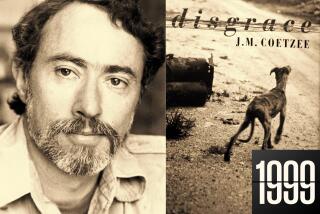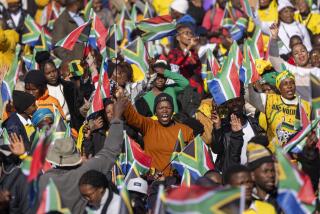Milking South Africaâs Sacred Cows : THE MIRROR AT MIDNIGHT; A South African Journey <i> By Adam Hochschild (Viking: $19.95; 289 pp.)</i>
Adam Hochschild spent the summer of 1962 working on one of South Africaâs white liberal newspapers. It was a Damascus road experience for Hochschild, who became suddenly and painfully aware of the silver spoon in his mouth, and resolved to spit it out. Back in America, he founded âMother Jones Magazine,â campaigned for the oppressed and downtrodden, and eventually became a political commentator of some renown.
He never forgot South Africa, though. It had become âthe landscape of my dreams,â so he returned to it from time to time to write magazine articles, and finally to research this book. The year was 1988, the 150th anniversary of the âGreat Trekâ that opened the country for white settlement and planted the seeds of the conflict raging today. In celebration, columns of bearded Boer horsemen donned period costume and escorted ox wagons down the highways to reenact their forefathersâ conquest of the African interior.
Hochschild followed these curious processions around the country for a month or two, meditating on the trek and its legacy of injustice, repression, police brutality, detention without trial and so on and so on, and so on. His rendition of these things is as heart-rending as any, but they have been repeated in so many books that one longs for a more original treatment. Even Archbishop Desmond Tutu âgroanedâ when Hochschildâs publisher asked him to supply a quote for âThe Mirrorâsâ cover.
In the end, Tutu rose to the occasion and endorsed the book, but he has a bigger heart than I. Indeed, âThe Mirror at Midnightâ put me in mind of a political rally I attended about a year ago. Walter Sisulu and other stalwarts of the struggle against apartheid had just been released from prison, and 80,000 people had gathered in a soccer stadium near Soweto to welcome them home. A band played African music, freedom songs were sung, and the leaders ran a lap of honor around the stadium. Then they sat down on the podium, right under a Communist Party flag.
This was a little embarrassing for reporters bent on portraying the ANC as a civil-rights movement in the Western democratic tradition. Around mid-afternoon, I fell in behind a foreign TV crew who were in town following a famous local writer around the territories, searching for an angle from which the ANC notables might be photographed sans their red backdrop. The hammer and sickle made it difficult to portray Sisulu and his comrades as reincarnations of Martin Luther King, so the journalists in question had decided to blot it out.
I did not have the pleasure of seeing the resulting documentary, but Adam Hochschildâs book is informed by a similar spirit of deception. He wants his readers to believe that South Africa remains a racist police state, the De Klerk reforms notwithstanding, and he is careful to manipulate his data accordingly.
Several such books have been written before, but Hochschildâs has the unique distinction of having been completed on July 1, 1990, well into the year of naked emperors and slaughtered sacred cows. South Africa has a tendency to make fools of those who claim insight into the future, and almost all the experts wound up with egg on their faces this year:
The ANC was unbanned and turned out to be incapable of signing up more than 150,000 members. Nelson Mandela told black children to go back to school, but nobody paid any heed. Rival black groups welcomed the era of reconciliation by falling on one another in an unprecedented orgy of killing. By July, 1990, the worst racists in the country were saying âTold you so,â and progressives of Hochschildâs ilk were tearing out their hair.
Under the circumstances, one cannot but admire Hochschildâs tenacity, his steadfast adherence to traditional anti-apartheid themes. Great swaths of his book are given over to accounts of torture and death in detention, and the sinister activities of death squads--an entirely valid line of inquiry, considering that some 30 black radicals died in police cells in the past decade and another 47 have been slain by mysterious assassins.
Thatâs 77 martyrs too many and yet, and yet, and yet . . . the dungeons of the secret police are not the only place where South Africans die. Those 77 martyrs are outnumbered 75-1 by the victims of internecine fighting in black communities, 10-1 by the number of people burned alive by revolutionary thugs in the past decade. They donât even equal the number of South African policemen killed in action last year, or the number of Shosas and Zulus butchered in a recent week in quasi-tribal fighting around Johannesburg.
South Africa is awash in blood. Looking at all of it makes you sick with confusion. Itâs so much easier to avert your eyes, as Hochschild does, and write about the safe, old South Africa, when noble anti-apartheid activists battle unspeakable white evil in the name of democracy and civil rights.
Hochschild has a soft spot for the ANC, portraying it as an essentially Christian movement, inspired by the ârebel priests of Latin America and Martin Luther Kingâ and led by men who understand âthe meaning of the vote, an opposition press, competing political parties and the rule of law.â There are thousands of decent people in the ANC, to be sure, but there are no clergymen whatsoever on its national executive committee. Its meetings open with chants of âViva Socialism!,â not prayers. Black reporters who irk the movement get death threats; members of rival black liberation organizations are sometimes fire-bombed or killed.
As for the rule of law, the ANCâs position must be considered in the light of Winny Mandelaâs recent elevation to an important executive post. Her bodyguards terrorized some dissenters and murdered at least four young people, but the movement nonetheless saw fit to appoint her its head of social welfare.
Ah, well, what can you say? Yesterdayâs truths are todayâs cliches, yesterdayâs heroes have feet of clay, and yesterdayâs news is history. Indeed, Hochschild was only 19 when he first came to South Africa, and he obviously was deeply scarred by the injustice he saw. South Africa was truly a dark place back then; the ANC was truly a movement of martyrs and moderates; the white state was truly vicious stupid and cruel.
Things change, though; Hochschildâs book would have been brave and revelatory 10 or even five years ago, but today it is merely dated.
More to Read
Sign up for our Book Club newsletter
Get the latest news, events and more from the Los Angeles Times Book Club, and help us get L.A. reading and talking.
You may occasionally receive promotional content from the Los Angeles Times.







